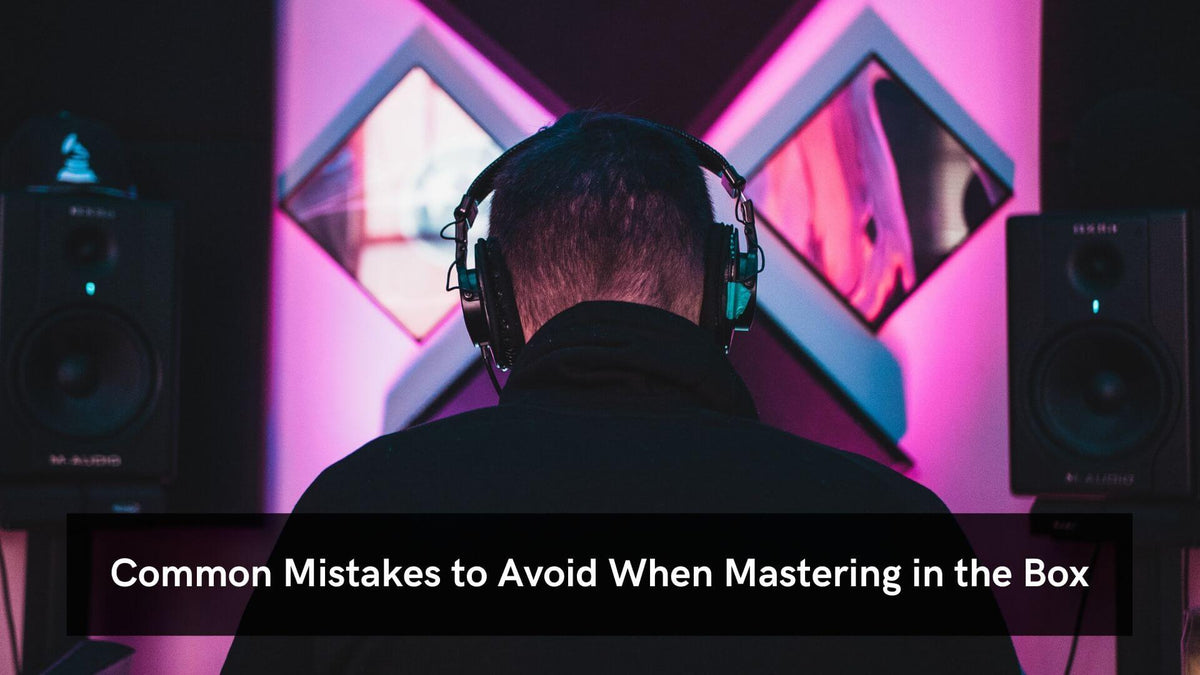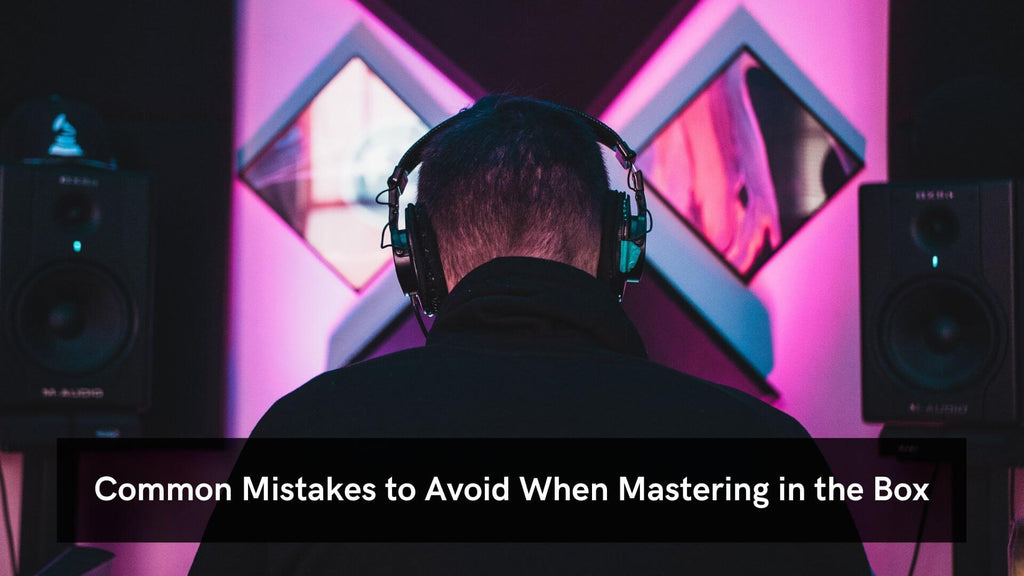To avoid common mistakes when mastering in the box, be mindful of the importance of gain staging and leaving headroom before applying processing. It is also crucial to refrain from overdoing processing and using too many plugins to avoid a cluttered mix.
Mastering in the box, or the digital domain, has become the method of choice for many music producers and engineers due to its convenience and cost-effectiveness. However, it also comes with its own set of challenges. One of the most common mistakes people make when mastering in the box is overlooking the need for proper gain staging and headroom before applying processing.
Over-processing and using too many plugins can also lead to a cluttered mix lacking clarity and depth. We will explore some other common mistakes to avoid when mastering in the box and how to achieve a clean and balanced final mix.

Credit: www.masteringthemix.com
Mixing In The Box Mistakes
Mistakes can happen when mastering music in the box. Common errors include overuse of compression and EQ, not referencing the mix on multiple speakers, and failing to give each element in the mix sufficient space and clarity. Avoiding these mistakes can lead to a better final product.
Mixing in the box can be tricky, and without the right guidance, even experienced mixing engineers can make mistakes. In this article, we will explore common mixing in the box mistakes and how to avoid them. Mixing in the box means that the mixing process takes place entirely inside the computer, often using digital audio workstations (DAWs), with no external mixing hardware involved.
Overdoing The Plugins
One of the most common mixing in the box mistakes is overdoing the plugins. It can be tempting to add numerous plugins to your mix, but this can quickly lead to a cluttered and distorted sound. It is best to stick with the essential plugins and learn how to use them to get the sound you desire. When using plugins, be mindful of their impact on the overall mix and use them sparingly.
Ignoring The Gain Staging
Another common mixing in the box mistake is ignoring the gain staging. It’s important to properly set the gain levels between each stage of your mix to avoid clipping, distortion, and noise. Proper gain staging will also ensure that the final mix has the desired loudness and a focused sound.
Relying Too Much On Templates
Another mistake that mixing engineers make is relying too much on templates. Although templates can be useful, they are not a one-size-fits-all solution for every mix. Each mix is unique and requires a tailored approach. It’s essential to listen to each element of your mix and determine the best way to enhance it. This will ensure that your mix stands out and has its unique sound. In conclusion, mixing in the box can yield excellent results when done correctly. By avoiding these common mixing in the box mistakes, you’ll ensure that your mix sounds great and meets the desired specifications. Remember to keep it simple, focus on clean gain staging, and let your mix have its unique sound.
Mastering In The Box Mistakes
Mastering in the box can be a challenging process to get right, especially when it comes to avoiding common mistakes. Some common mistakes to avoid include over-compressing, over-limiting, and failing to check your mix in mono. However, with a careful approach and attention to detail, it’s possible to achieve great results mastering in the box.
Mastering in the box is a great way to achieve professional-sounding final tracks. However, there are some common mistakes that many beginners make with mastering in the box. These mistakes can hold you back from achieving the sound you want. In this post, we’ll dive into some common mastering in the box mistakes.
Using Too Much Compression
Compression is essential in mastering, but using too much can be a mistake. Too much compression can make the track sound unnatural and squeezed. When you use a lot of compression, parts of the track that should have dynamics end up sounding flat. You should use compression in moderation. Make sure to strike a balance between dynamics and volume.
Not Paying Attention To Eq Balance
Balancing the EQ in mastering is crucial. EQ affects the overall tonality of the track. If the EQ is imbalanced, then the entire mix can sound off. Make sure to use a proper reference track when mixing to get an idea of how your track can sound. Afterward, it’s vital to use spectrum analyzers to make sure your track falls in the same frequency range as professional tracks.
Ignoring The Loudness War
The “loudness war” is a term used to describe the competition for maximum loudness between different tracks on the market. This issue arose because of a technical flaw in digital audio signals that made loudness potential endless. Many mastering engineers mistakenly aim for maximum loudness, competing with other tracks. However, this can result in lack of dynamic range, and losing transients which make tracks sound lively. In conclusion, mastering in the box is a learning process that requires diligence and patience. It’s important to avoid the common mastering in the box mistakes outlined in this post – using too much compression, not paying attention to EQ balance, and ignoring the loudness war. By following a systematic approach and avoiding these issues, you’ll be able to achieve professional-level mastering at home.
Monitoring Mistakes
If you’re new to audio mastering and plan to tackle it in the box, you need to know the common monitoring mistakes that you should avoid.
Using Bad Quality Headphones
Using bad quality headphones is one of the most common monitoring mistakes. Headphones may be more convenient, but not all headphones are designed for audio mastering. Low-quality headphones tend to boost or cut certain frequency ranges, giving you an inaccurate representation of your mix.
When using headphones, always ensure that they are of high quality and specifically designed for audio engineering. Also, avoid using noise-canceling headphones as they can affect the perceived sound quality.
Not Calibrating Your Studio Monitors
Another common monitoring mistake is not calibrating your studio monitors. Failing to calibrate your monitors can lead to mixing and mastering in an unbalanced listening environment. Monitor calibration is the process of adjusting your speakers’ output to achieve a neutral, flat frequency response, providing an accurate representation of the audio.
Here are some steps to follow when calibrating your studio monitors:
- Ensure that your room is equipped with acoustic treatment to minimize room reflections and standing waves.
- Position your studio monitors at the correct height and distance from your ears.
- Use a measurement microphone and software to measure your room’s frequency response and adjust the monitor’s output accordingly.
- Periodically check the calibration to ensure the accuracy of your monitoring setup.
Mastering in the box needs a cautious ear and accurate monitoring, and avoiding monitoring mistakes is an essential part of achieving a professional-sounding mix. With the tips mentioned above, you can achieve an accurate representation of your mix and ensure that your mastering process yields the best possible results.

Credit: www.masteringthemix.com
Workflow Mistakes
When it comes to music production, mastering plays a crucial role in ensuring that your music sounds professional and polished. With the advent of digital audio workstations (DAWs), mastering in the box has become a popular choice for many producers. However, just like any other technique, mastering in the box has its fair share of mistakes that you should avoid. In this article, we’ll focus on workflow mistakes that can hinder your progress and affect the quality of your final mix.
Not Organizing Your Sessions
One of the biggest mistakes you can make when mastering in the box is not organizing your sessions. It’s easy to get carried away with plugins and effects, but if you’re not keeping track of what you’re doing, you can quickly lose sight of your original mix. That’s why it’s essential to create a system for organizing your sessions. This can include labeling tracks, grouping similar elements, and color-coding to make your workflow more efficient.
To keep your sessions organized, consider creating a template that you can use for all your mastering projects. This template should include all the plugins and effects you typically use and be set up with a consistent routing and naming convention. By doing this, you’ll save time and ensure that your workflow remains consistent, regardless of the project you’re working on.
Not Taking Breaks To Refresh Your Ears
When you’re working on a mix, it’s easy to get lost in the details and lose perspective on the big picture. This is especially true when mastering in the box, where you’re dealing with small changes that can have a significant impact on the final mix. That’s why it’s essential to take regular breaks to refresh your ears and give your brain a rest.
How often you take breaks depends on your personal preference, but a good rule of thumb is to take a five or ten-minute break every hour. During this time, step away from your computer and do something that doesn’t involve sound or music. This can be as simple as taking a walk, stretching, or closing your eyes and meditating. By taking regular breaks, you’ll be able to return to your mix with fresh ears and a clear mind.
Conclusion
Mastering in the box is a powerful technique that can help you achieve professional results. However, it’s essential to be aware of the mistakes that can affect your workflow and the quality of your final mix. By organizing your sessions and taking breaks to refresh your ears, you’ll be able to avoid these common mistakes and produce better results.

Credit: www.masteringthemix.com
Frequently Asked Questions Of Common Mistakes To Avoid When Mastering In The Box
At What Db Should Beat Be Before Mastering?
There is no specific dB level for beats before mastering as it depends on the track and desired sound. However, it is recommended to keep the levels below 0 dB to avoid distortion. It is important to have a balanced mix and use the right EQ and compression settings to achieve the desired sound.
What Is Too Loud For Mastering?
The loudness level that is too much for mastering can vary depending on the genre, but in general, it’s recommended to aim for a maximum peak level of -1 or -2dB and a loudness level of -16 to -14 LUFS.
Exceeding these levels can result in distortion, loss of dynamics, and poor sound quality.
How Do You Tell If Your Song Is Mastered Properly?
To tell if your song is mastered properly, listen to it on different devices and in different environments. Check if all the instruments and vocals are balanced and well-defined. Look for any distortion or clipping in the audio. Make sure the song’s volume and overall sound are consistent with other professional music.
How Do I Stop Distortion When Mastering?
To prevent distortion during mastering, you should ensure that your levels are not too loud, use equalization to balance frequencies, and consider using a limiter. Additionally, avoid excessive compression and saturation and test your master on various audio systems.
Conclusion
Mastering in the box can be a daunting task, especially for beginners. However, avoiding common mistakes can make the process much easier. Remember to take breaks, experiment with different techniques, and don’t be afraid to ask for help. With time and practice, you can become a pro at mastering in the box.
Avoiding these mistakes will allow you to elevate your skills and produce top-quality music. Keep these tips in mind and happy mastering!